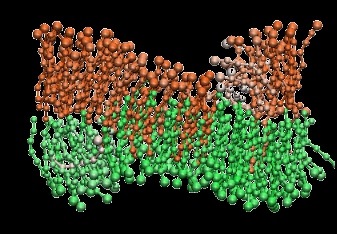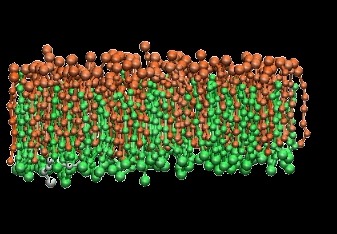
Lipid bilayers and incorporated proteins form biological membranes. Usually the microscopic surface tension of membranes is small or vanishes altogether, but there may also be situations, where membranes are under considerable stress due to osmotic pressure differences or during conformational changes, fission or fusion of cells. Epithelial cells, e. g., exposed to transmembrane osmotic gradients, can be expected to develop a state of tension under physiological conditions [d1]. Therefore, the aim of our work is to study the effect of an applied tension on the physical properties of a model bilayer.
Using an generic coarse-grained model [d2] we analyze model bilayers systematically ranging from simulation temperatures, which correspond to the gel-phase of the bilayer, up to temperatures, where the system is within the fluid phase.

The focus of our work lies on conformational variations and changes in mechanical properties of the bilayers when external tension is applied. In the fluid phase, for example, an interdigitation of the lipids takes place as the tension increases. This, in turn, influences not only properties like the thickness of the bilayer and the average area per lipid but also effects the fluctuation spectra considerably. Both fluctuations in height and peristaltic modes of the bilayer are suppressed in systems under tension. A fact that can be quantitatively confirmed by analyzing the fluctuation spectra of the model membranes.
b) Old publications
c) Completed work
- J. Neder, dissertation: Coarse-grained simulations of membranes under tension and lipid-protein interactions (2011).
d) References
- G. Soveral, R.I. Macey, and T.F. Moura, Biology of the Cell 89, 275 (1997).
- O. Lenz, F. Schmid, J. Mol. Liq. 117, 147 (2005); Phys. Rev. Lett. 98, 058104 (2007).
e) External links (programs, potentials ...)
f) Books
J. Neder, dissertation, Verlag Dr.-Hut (2011).
